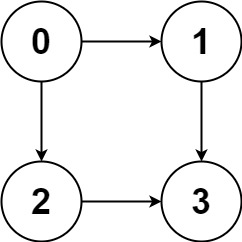797. All Paths From Source to Target
问题:
给定一个【0~n-1】n个节点构成的有向图,
求从0到n-1的所有路径。
graph[i]=[a,b,c...]
指:节点i 指向 节点a,b,c...
Example 1: Input: graph = [[1,2],[3],[3],[]] Output: [[0,1,3],[0,2,3]] Explanation: There are two paths: 0 -> 1 -> 3 and 0 -> 2 -> 3. Example 2: Input: graph = [[4,3,1],[3,2,4],[3],[4],[]] Output: [[0,4],[0,3,4],[0,1,3,4],[0,1,2,3,4],[0,1,4]] Example 3: Input: graph = [[1],[]] Output: [[0,1]] Example 4: Input: graph = [[1,2,3],[2],[3],[]] Output: [[0,1,2,3],[0,2,3],[0,3]] Example 5: Input: graph = [[1,3],[2],[3],[]] Output: [[0,1,2,3],[0,3]] Constraints: n == graph.length 2 <= n <= 15 0 <= graph[i][j] < n graph[i][j] != i (i.e., there will be no self-loops). The input graph is guaranteed to be a DAG.
Example 1:

Example 2:

解法:Backtracking(回溯算法)
- 状态:到当前节点为止,加入的路径path。
- 选择:当前节点 i 的下一个节点 graph[i] list
- 当前节点:path的最后一位。
- 退出递归条件:path的最后一位=n-1
代码参考:
1 class Solution { 2 public: 3 void dfs(vector<vector<int>>& res, vector<int>& path, vector<vector<int>>& graph, int pos) { 4 if(path[pos]==graph.size()-1) { 5 res.push_back(path); 6 return; 7 } 8 if(pos==graph.size()) { 9 return; 10 } 11 for(int nxt:graph[path[pos]]) { 12 path.push_back(nxt); 13 dfs(res, path, graph, pos+1); 14 path.pop_back(); 15 } 16 return; 17 } 18 vector<vector<int>> allPathsSourceTarget(vector<vector<int>>& graph) { 19 vector<vector<int>> res; 20 vector<int> path(1,0); 21 dfs(res, path, graph, 0); 22 return res; 23 } 24 };




